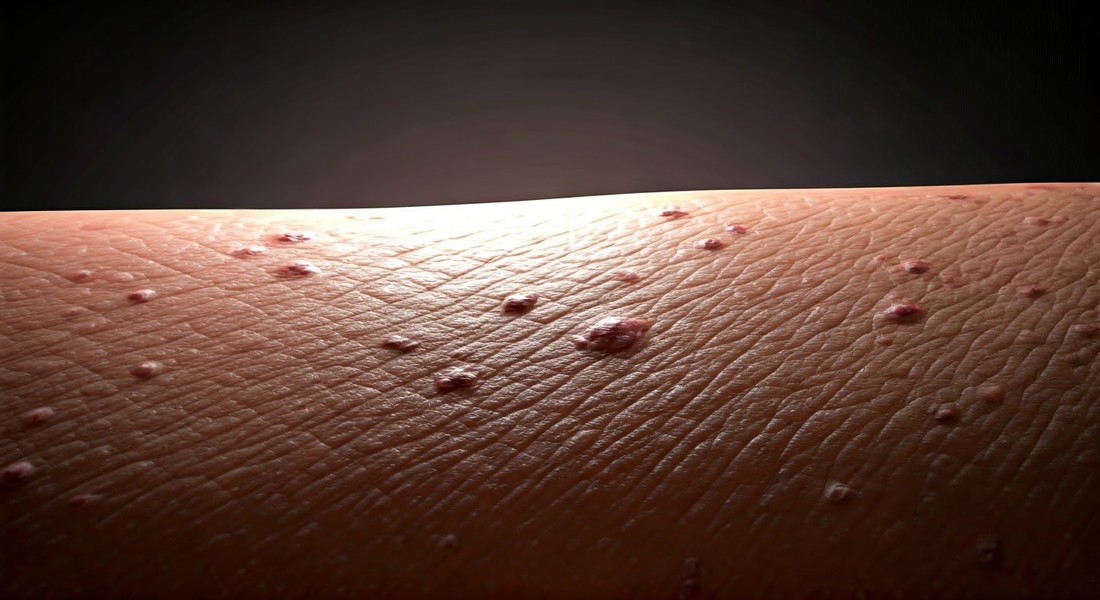
Understanding Psoriasis: What Symptoms Should You Look For?
Share

Key Highlights
-
Psoriasis is a chronic skin condition that speeds up the life cycle of skin cells, leading to a buildup of cells on the surface of the skin and causing inflammation and thick, scaly patches.
-
It is not contagious but is considered an immune system problem.
-
There are several types of psoriasis including plaque, guttate, pustular, and erythrodermic psoriasis.
-
Symptoms of psoriasis can vary but often include red patches of skin, scaly skin, itching, burning, and pain.
-
Triggers for psoriasis can include stress, infections, cold weather, and skin injuries.
Introduction
Psoriasis is a common skin condition that lasts a long time. It happens when the immune system sends wrong signals. This makes skin cells grow too fast. As a result, skin cells pile up on the surface, creating itchy and scaly patches. Knowing the symptoms of psoriasis is important. This helps in finding it early and managing it properly.
Identifying Psoriasis
Psoriasis shows different symptoms, so it’s important to know the different types of psoriasis. Some people only have mild symptoms, but others may feel a lot of discomfort and have physical limits.
The way psoriasis looks can change based on things like skin type, how serious it is, and the specific type of psoriasis. Common signs are red patches of skin. These patches are usually covered with silvery-white scales, and they can be itchy, dry, and sometimes painful.
How psoriasis develops
In someone with psoriasis, the immune system wrongly attacks normal skin cells. It reacts like it's fighting an infection or trying to heal a wound. This makes the skin cells grow faster, taking just days to produce new cells instead of weeks.
As a result, skin cells pile up quickly on the surface. This causes thick, scaly patches called plaques. In people without psoriasis, skin cells grow and shed slowly over a month.
Knowing this process shows why psoriasis isn't just a cosmetic issue. It is a long-term condition that needs continuous care to manage its symptoms well.
Recognizing the Initial Signs of Psoriasis
Initially, psoriasis shows up as small, red patches of skin. People often think these patches are just dry skin or other skin issues. They might feel itchy or tender. As the condition gets worse, the patches can grow larger and thicker, turning into plaques.
It's important to notice these early signs. Getting medical help quickly can change how the condition develops. Look out for any strange skin changes, especially if psoriasis runs in your family.
Also, keep an eye on where these patches appear. Psoriasis often shows on the lower back, elbows, knees, and scalp. However, it can show up on any part of the body, like the face, palms, and soles of the feet.
Differentiating Between Psoriasis and Other Skin Conditions
Figuring out if your symptoms are from psoriasis or another skin condition like eczema usually needs a doctor’s diagnosis. Both have red, itchy patches on the skin, but they are different.
Psoriasis shows up as raised spots that have shiny white scales on them. Eczema, on the other hand, looks like swollen, itchy patches that might leak or have crusts. Eczema is more common in kids, while psoriasis usually happens in adults.
A dermatologist can tell the difference between these skin conditions. They will look at the appearance of your skin, check your medical history, and, hopefully, do a biopsy.
Symptoms
 Psoriasis symptoms can look different for everyone. They may also vary based on the type of psoriasis someone has. The symptoms can be mild, showing small patches on the skin, or they can be severe, affecting large areas of the body.
Psoriasis symptoms can look different for everyone. They may also vary based on the type of psoriasis someone has. The symptoms can be mild, showing small patches on the skin, or they can be severe, affecting large areas of the body.
It's important to recognize the specific symptoms of each type of psoriasis. This helps doctors diagnose the condition and decide on the best treatment. Let’s explore the different ways psoriasis shows up:
Plaque psoriasis
Plaque psoriasis is the most common type of this skin condition. It shows up as raised, red patches of skin with silvery-white scales. These patches are often itchy and dry. You can usually find them on elbows, knees, the lower back, and the scalp.
The scaly skin seen in plaque psoriasis is due to a quick buildup of skin cells. This happens when skin cells grow faster than they can be shed, leading to those unique plaques. The severity of plaque psoriasis can change. Some people may have times when their symptoms ease, while others may face ongoing issues.
Treating plaque psoriasis often uses a mix of creams applied to the skin, light therapy, and, for more severe cases, oral or injectable medications. The goal of treatment is to reduce inflammation, slow down the growth of skin cells, and help with the discomfort from the condition.
Guttate psoriasis
Guttate psoriasis usually happens in childhood or young adulthood. It shows up as small, drop-shaped, red spots mostly on the torso, arms, and legs. These spots are smaller and thinner than the ones seen in plaque psoriasis, but they can still have fine scales on them.
This type of psoriasis is often caused by a bacterial infection, especially strep throat. It often appears a few weeks after the infection. While guttate psoriasis can go away on its own, some people may have recurring episodes throughout their lives.
For treatment options, it helps to treat the underlying infection. People may also use topical corticosteroids and phototherapy, PsoriasEze offers an all natural alternative. It is important to manage triggers like stress and skin injuries to control this type of psoriasis.
Inverse psoriasis
Inverse psoriasis is a less common type of psoriasis. It impacts skin folds and causes smooth, red patches. These patches usually appear in places like the armpits, groin, under the breasts, and behind the knees. Friction and sweating can make this condition worse, increasing discomfort.
What makes inverse psoriasis different from other forms is that it does not have the usual silvery-white scales. Instead, the affected skin looks smooth, shiny, and inflamed. This type can be very annoying since it appears in sensitive areas that often get rubbed or are damp.
To treat inverse psoriasis, it is important to follow gentle skincare routines. Keep the affected areas clean and dry, and avoid irritants. Doctors often prescribe topical corticosteroids in low doses to help reduce inflammation. This form is often misdiagnosed as eczema. PsoriasEze helps!
Nail psoriasis
Nail psoriasis affects both fingernails and toenails. It changes how they look and feel. Common signs include tiny dents, color changes, thickening, and the nail separating from the nail bed (onycholysis).
Sometimes, the nail may crumble or completely come off. Treating nail psoriasis can be tough because it’s in a hard-to-reach spot. People with this condition might also deal with joint issues caused by psoriatic arthritis.
Treatment often includes applying creams or ointments directly to the nails. Phototherapy is another option. In severe cases, doctors may suggest oral or injectable medications. It is important to treat nail psoriasis early. This helps prevent lasting damage to the nails. PsoriasEze can help nails to grow back over time.
Pustular psoriasis
Pustular psoriasis is a rare but serious type of psoriasis. This condition causes pus-filled blisters, known as pustules, that are surrounded by red skin. It can affect small areas of the body, like the hands and feet, which is called palmoplantar pustulosis. Or it can cover a large part of the body, known as generalized pustular psoriasis.
The pustules often look like white or yellowish bumps on the skin. Pustular psoriasis can be triggered by different things, such as medications, infections, stress, or hormonal changes. In some severe cases, it can be life-threatening and needs immediate medical help.
There are several treatment options available. These include topical corticosteroids, oral retinoids, phototherapy, and biologic medications. It’s important to manage the triggers and any underlying health problems to control this type of psoriasis.
Erythrodermic psoriasis
Erythrodermic psoriasis is a serious type of psoriasis. It can cover the skin with a bright red rash all over the body. This form of psoriasis is more dangerous than other types. It needs quick medical care because it can be life-threatening. It often makes the skin peel off in large pieces, causing loss of fluids and proteins. This can be harmful to health. The skin might look burned, and people may feel extreme itching and pain. It is important to know the symptoms and get treatment fast.
Risk factors
The exact cause of psoriasis is not known.
Other risk factors are a weak immune system, infections from viruses and bacteria, some medications, smoking, being overweight, and stress. These things can either start psoriasis or make its symptoms worse. Knowing about these risk factors is important for preventing and managing the condition well.
Complications
Psoriasis, if left untreated or unmanaged, can lead to several complications that affect not only the skin but also other parts of the body. One common complication is psoriatic arthritis, where joint pain and swelling occur, impacting mobility. Moreover, severe cases of psoriasis may increase the risk of developing conditions like heart disease, high blood pressure, and liver disease. In rare instances, erythrodermic psoriasis can cover large areas of the body with red, inflamed skin, posing a risk of serious infection and disrupting the body's ability to regulate temperature. Patients with psoriasis should be vigilant about these potential complications and work closely with healthcare providers to prevent and address them promptly to maintain overall health and well-being.
Triggers and Aggravating Factors for Psoriasis
The cause of psoriasis is unknown. However, different outside factors can trigger or make symptoms worse, which leads to flare-ups. It is important for people with psoriasis to find out what these triggers are. This helps them manage their condition better.
While it might not be possible to avoid every trigger, being aware of them can help people reduce their exposure. This can lower how often and how badly psoriasis flare-ups happen, making it easier to control the condition.
Understanding What Can Worsen Psoriasis Symptoms
Psoriasis triggers can be different for each person. Still, some common ones can make symptoms worse. Knowing these triggers can help people with psoriasis to take steps to avoid or reduce their effects.
Common triggers for psoriasis flare-ups include:
-
Stress: High levels of stress can make psoriasis symptoms worse. This shows how important it is to manage stress.
-
Infections: Bacterial and viral infections, such as strep throat and skin infections, are known to trigger psoriasis.
-
Skin injury: Cuts, scrapes, and even insect bites can cause psoriasis in those who are sensitive to them.
Lifestyle Factors Influencing Psoriasis Flare-ups
Lifestyle choices play a pivotal role in managing psoriasis flare-ups. Stress, a significant trigger, can exacerbate symptoms due to its impact on the immune system. Maintaining a healthy weight is crucial as obesity is linked to a higher risk of psoriasis and can worsen the condition. Smoking is another factor that can intensify psoriasis symptoms and decrease the effectiveness of certain treatments. Additionally, excessive alcohol consumption can trigger flare-ups and interfere with medications. Proper skincare routines, including moisturizing regularly and avoiding harsh products, can help alleviate symptoms. Adopting a balanced diet rich in anti-inflammatory foods may also aid in managing psoriasis. Understanding and addressing these lifestyle factors can significantly improve the overall management of psoriasis symptoms.
When to Seek Medical Advice
If you notice persistent red patches of skin, scaly skin that doesn't improve with moisturizers, joint pain, or nail bed changes, it's advisable to seek medical advice promptly. Additionally, if you experience severe itching, skin discomfort, or any other unusual symptoms on various parts of the body, consulting a healthcare professional is recommended. Skin conditions can sometimes be challenging to diagnose accurately without medical expertise, especially when dealing with different types of psoriasis or related complications. Early intervention can lead to a more effective treatment plan, potentially improving your quality of life. Remember, timely medical intervention plays a crucial role in managing psoriasis and preventing potential aggravation.
Conclusion
Psoriasis is a chronic skin condition that can significantly impact the quality of life of those affected. By understanding the symptoms and triggers, individuals can better manage their condition. Seeking medical advice when experiencing persistent symptoms is crucial for proper diagnosis and personalized treatment. Through various treatment options, including topical treatments and lifestyle modifications, individuals can alleviate symptoms and reduce flare-ups. It's essential to differentiate between psoriasis and other skin conditions to receive appropriate care. A biopsy is essential for correct diagnosis. Overall, staying informed about psoriasis, its symptoms, and available treatments can help individuals lead a more comfortable life despite the challenges posed by this condition. Remember, early intervention and proactive management are key in effectively dealing with psoriasis.
Frequently Asked Questions
What are the first signs of psoriasis?
The first signs of psoriasis usually look like small, red spots with scaly skin. These spots often show up on the elbows, knees, or scalp. Many people confuse them with dry skin or other skin problems.
How can I tell if it's psoriasis or eczema?
Psoriasis and eczema differ in appearance; psoriasis typically has thicker, silvery scales, whereas eczema is more red and scaly. Consulting a dermatologist for proper diagnosis is crucial due to similarities in symptoms. Understanding the distinctions can help in accurate identification.
What can I expect if I have psoriasis?
Psoriasis is a long-lasting condition. This means it does not go away and can be a constant part of your life. Many people have times when their symptoms get worse and times when they feel better. By having a good treatment plan, you can control your symptoms and enjoy a good life.
What part of my body will psoriasis affect?
Psoriasis can affect various parts of the body, commonly appearing on the scalp, elbows, knees, and lower back. It can also manifest on the nails, palms, soles of the feet, face, and even genital area. Understanding its locations aids in early detection and management.
What does psoriasis look like when it starts?
Psoriasis is a chronic skin condition that typically presents as small, red patches or bumps with scales in the initial stages. These patches may cause itching or soreness and are frequently mistaken for dry skin or other dermatological problems. As psoriasis progresses, these patches can grow in size and number, leading to thicker scales and potential bleeding if the skin is scratched or irritated. It is essential for individuals experiencing these symptoms to consult a dermatologist for an accurate diagnosis and appropriate treatment plan tailored to their specific needs. Early detection and management of psoriasis can help alleviate discomfort and prevent potential flare-ups in the future.
Can the symptoms of psoriasis vary in severity?
Yes, psoriasis symptoms can vary in severity. They can range from mild with small patches of red, scaly skin to severe cases covering large areas. Factors such as stress, infections, and certain medications can worsen symptoms. Understanding these variations is key to managing psoriasis effectively.
Do lifestyle factors affect the manifestation of psoriasis symptoms?
Lifestyle factors like stress, diet, and smoking can impact the severity of psoriasis symptoms. Stress management, healthy eating habits, and avoiding triggers may help in managing psoriasis effectively. Understanding these influences is crucial for individuals with psoriasis.

